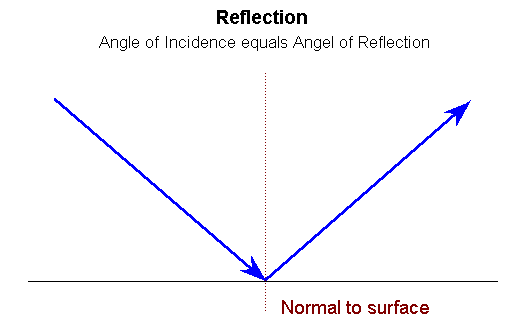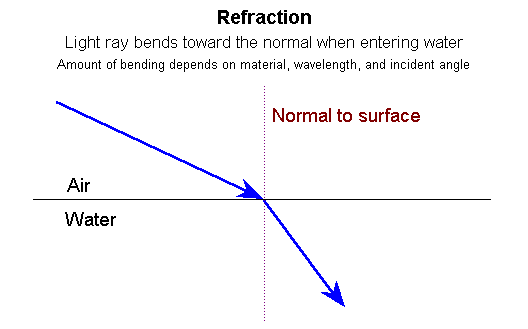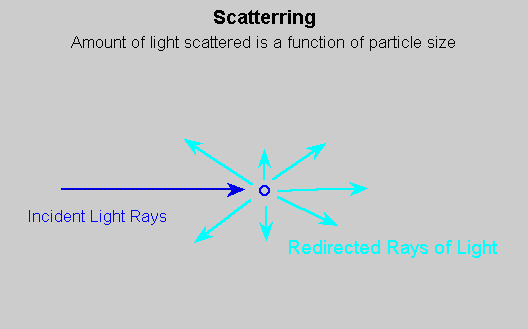
A gem can be defined as something that is valued for its beauty. Atmospheric gems are generated by the type and size of particles suspended in the atmosphere and their relationship to the position of the sun and viewer. Unlike gems worn has ornaments, atmospheric gems are generated by groups of particles that have similar sizes and shapes, not by single entities.
Nearly half of solar energy has wavelengths in the visible spectrum: 0.4-0.7 microns. Our eyes are sensitive to energy in this portion of the electromagnetic spectrum. The rods in our eyes distinguish light from dark. The cones sense color. White light is perceived when all visible light strikes the cones with nearly equal intensity. Fire emits visible light -- we will focus on colors that are not generated by the object's temperature, i.e. emission. Leaves are green because leaves, or chlorophyll inside the leaves, reflects green light. Most of what we see is due to reflection of incident light.
In reflection, the angle of incidence is equal to the angle of reflection. Sunlight reflects the surface at the same angle it strikes the surface.

Examples:
Light that passes through a substance is said to be transmitted. Upon entering a denser substance, transmitted light slows in speed. If the light enters at an angle, the light's path bends. This bending is termed refraction.

Light that travels from a less-dense to a more dense medium looses speed and bends toward the normal. Snell's law defines the relationship between the incident angle and the refracted angle.
Scattering is when solar radiation is deflected from its path in all directions. Scattering is caused by particles in the atmosphere. The color of the light scattered is a function of the particle size in relation to the wavelength.

Cloud droplets scatter all colors in all directions. Clouds appear dark underneath - due to scattering of visible light out the sides and top of the cloud.
Air molecules are much smaller than the cloud droplets. Molecules are wavelength selective in the light they scatter. They are more efficient at scattering light with a short wavelength violet, blue, green. This explains why the sky is blue. Dust on Mars turns the sky red with violet sunsets because these size particles scatter red light.
Multiple scattering occurs when a ray of light interacts with a multitude of particles. Multiple scattering destroys colors.
Examples of multiple scattering include:
Refraction is a function of wavelength. This is referred to as dispersion. In refraction the longer wavelengths (red) slow down the least and shorter wavelengths slow the most. Red light bends the least, violet the most. Lead crystals that you hang in your window to cast "rainbows" are a demonstration of the dispersion of light. The 'rainbows' thrown by lead crystals are more similar to sundogs then rainbows and are more. Sun dogs are generated when light interacts with hexagonal plate like ice crystals that are approximately 30 microns in size and fall horizontally. The ice crystals disperse the sun's light. Notice on the sun dog that the red light is on the inside, as red light bends the least.